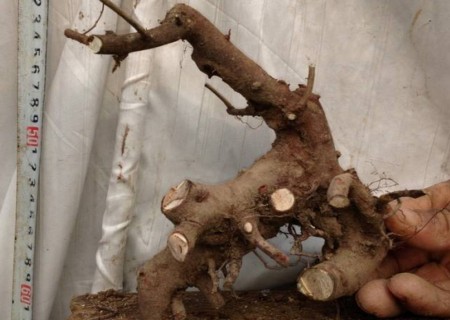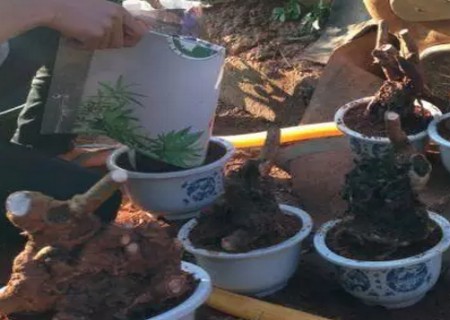How to plant mountain piles under bonsai
The determination of the transplanting time of bonsai piles has always had its own opinions. According to my own experience of planting piles, it is generally necessary to vary from time to time and from place to place, and should not be treated rigidly. The transplanting time in southwest China should generally be free of rain, snow and frost, and deciduous tree species and cypresses can be transplanted before the Waking of Insects in the early winter to the following year. Evergreen tree species and cold-resistant tree species can be warmed up in spring, and the best time is from early March to late April. When transplanting, attention should be paid to preserving the fibrous root as much as possible, which is the lifeline for the survival of this pile and the normal transport of nutrients. Therefore, the key to the survival of the new pile is to understand the ecological habits of all kinds of tree species and the selection of local climatic conditions.

Downhill pile is good and cheap, but there are certain risks, how to reduce the risk to the minimum and maximize the survival rate? Now let's talk about how to plant the mountain piles under the bonsai.
1. Promoting root
In order to improve the survival rate of the new stump, the key is to make it take root early and grow rapidly. For the root of the new stump to form quickly, attention must be paid to trimming the end of the main root so that the new root can grow around the new section. In addition, around the thicker roots, you can also use a sharp knife to gently split in different directions, generally from the wound around the young roots, you can also use plant growth regulation to promote the stump head to take root.
2. Shortening the time when the stump leaves the soil.
Generally speaking, tree stumps are dug back from the mountains, ranging from three to four days to as many as ten days and eight days. if they are shelved for too long, the trees will only evaporate and will be easily dehydrated and withered without water replenishment. Therefore, we must seize the opportunity to plant as soon as possible and shorten the time for the stumps to leave the soil. Soil is the main source of plant nourishment. When planting new trees to cover the soil, we should pay attention to ventilation and drainage, and gently compact the soil, so that every root of the root is closely connected with the soil, so that the root must be attached to the mud, and the mud must stick to the root.
3. Sealing
After the stump of the new tree has been cut and trimmed, there are many knife-saw-axe-chiseled wounds. The easiest way is to smear the wound with beeswax, foreign wax and latex, or wrap it with strips of cloth. It should be noted that all old wounds should be re-cut or cut, and be closed immediately after cutting. Sealing the wound can not only prevent the invasion of bacteria, but also play a certain role in preventing water evaporation.
4. Transporting water
The newly planted tree head should not be drenched with water, otherwise the stump will sprout too much and the root will grow too slowly to supply the evaporation of the bud, which will cause the stump to wither. Therefore, we must control the amount of water as much as possible, and wait until the occurrence of new roots and new buds, according to the number of buds, pour the right amount of water on it. Dark places of plants are easy to take root, and when the branches and leaves are luxuriant, they can give more water and sunshine to facilitate the growth of plants.
5. Fertilization
The stumps of newly planted trees are generally unable to apply fertilizer, especially early fertilization will make the stumps "indigestible". However, practice has proved that this is not the case. as long as we can grasp the development of the stump head, especially after the new roots grow, we should strive to apply appropriate thin liquid fertilizer in time, which can promote the growth of fibrous roots and the growth of branches and leaves.
Good stakes are rare, and it is not easy to feed. Artists are engaged in bonsai creation, and the stump management should follow the combination of the law of tree growth and local conditions at that time, pay attention to science, rather than lazy, careful, serious, turn decay into magic, make ordinary into exquisite, feed silly wood bumps one by one, and process them into high-level works of art-tree stump bonsai. The following are taboos for the maintenance of downhill piles:
1. Avoid shallow burial
Even if it is a fresh stump with broken skin and wind green, the relationship between trapped injuries should also be treated as a "serious illness". It must be buried deeply, basically buried only at the top of the exposed top, and covered with floating soil or plastic bags, so that the deep-buried pile can remain moist for a long time after pouring water, and it is easy to promote the survival of buds. Shallow buried, the upper part is exposed, it is difficult to do the work in the wind and sun.
2. Taboo frequency check
Generally, even if the buried stump is sprouting and strong, it should not be taken out as a living stump, because the upper bud and long branch is often seen in the lower long root, if you always check whether the lower part is long root and take it out again and again from time to time, it will undoubtedly hinder normal rooting; besides, if you have new roots, you should not easily take out and hurt tender and crisp buds.
3. Avoid sparse watering
After the pile head is buried and watered through, don't forget to pour it again after it is drier. The injured pile is originally short of roots in the lower part, and moisture is volatilized from the upper wound, so it is most important to ensure that it is moist and not waterlogged in the danger of "life". It is likely to die if it is not kept for a long time. Do not take the issue of moisturizing lightly.
4. Avoid misinspection
During the process from cutting down stakes to surviving, cutting roots and branches in the front section caused sudden serious injury to the plant, which prolonged dormancy and went into "fake death". At this time, we should wait properly, but it is not easy to "wake up" if dormant for too long. When the vitality of the pile is raised by warm and wet maintenance, the buds will be born with the vitality in the pile and enter the "fake life". At this time, no new roots will grow, and even when the new roots grow, they will not reach the real life, because these young roots are not enough to absorb enough water and nutrients to supply the stumps, so they still need to continue to bury the piles to make them strong. So don't just look at the surface and decide whether it's alive or dead.
5. Fear of floating
The posture of the pile head designed for the first time should be considered repeatedly, and the removal of the main root, big root, big branch and other heavy processing should be carefully considered before it can be determined, but once determined, it will not be easily changed. Cutting changes will often prolong the dormancy of stumps, and frequently changing your mind to remove new buds can also lead to stumps from "fake death" to real death. A restless heart is extremely disadvantageous to pile maintenance.
Time: 2019-06-03 Click:
- Prev

How to maintain the pile under the mountain of Finch plum
Sparrow plum, also known as thorn, sparrow plum vine, sour fruit, sour young tree, is a deciduous climbing shrub of the family Rhamnaceae. The bark is grayish brown and the branchlets are slender with needles. Leaves opposite, ovate or elliptic, margin serrulate, thinly leathery and bright green. Small yellowish flowers in autumn and winter, drupe nearly globose, purple-black when ripe, edible
- Next

Transplanting method of mountain piles under bonsai
The downhill stump, that is, the wild tree stump dug in the mountain, is used as bonsai material. In general, such materials have strange, dangerous, simple and elegant effects that are difficult to achieve by hand. Perhaps, your burning material is someone else's bonsai material. Based on his own understanding of bonsai pile transplantation for more than ten years, the editor
Related
- Fuxing push coffee new agricultural production and marketing class: lack of small-scale processing plants
- Jujube rice field leisure farm deep ploughing Yilan for five years to create a space for organic food and play
- Nongyu Farm-A trial of organic papaya for brave women with advanced technology
- Four points for attention in the prevention and control of diseases and insect pests of edible fungi
- How to add nutrient solution to Edible Fungi
- Is there any good way to control edible fungus mites?
- Open Inoculation Technology of Edible Fungi
- Is there any clever way to use fertilizer for edible fungus in winter?
- What agents are used to kill the pathogens of edible fungi in the mushroom shed?
- Rapid drying of Edible Fungi

